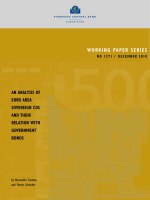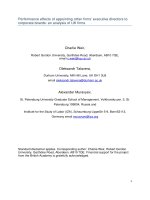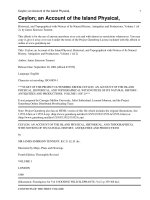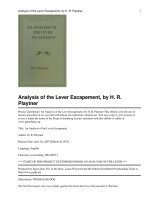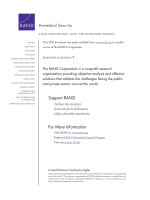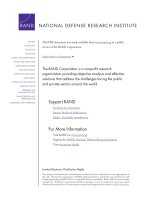An analysis of chinese state owned entities and financial markets market versus political incentives
Bạn đang xem bản rút gọn của tài liệu. Xem và tải ngay bản đầy đủ của tài liệu tại đây (410.53 KB, 119 trang )
AN ANALYSIS OF CHINESE STATE-OWNED ENTITIES
AND FINANCIAL MARKETS: MARKET VERSUS
POLITICAL INCENTIVES
LI, ZHAOHUA
NATIONAL UNIVERSITY OF SINGAPORE
2007
i
AN ANALYSIS OF CHINESE STATE-OWNED ENTITIES
AND FINANCIAL MARKETS: MARKET VERSUS
POLITICAL INCENTIVES
LI, ZHAOHUA
(
MBA
)
, MAASTRICHT SCHOOL OF MANAGEMENT
A THESIS SUBMITTED
FOR THE DEGREE OF
DOCTOR OF PHILOSOPHY
DEPARTMENT OF FINANCE AND ACCOUNTING
NATIONAL UNIVERSITY OF SINGAPORE
i
ACKNOWLEDGEMENTS
Working on this thesis has been an inspiring, sometimes exciting, often challenging, but always
interesting experience that has been made possible by many people who have supported me.
I am very grateful to my supervisor, Dr. Takeshi Yamada, who has guided me mentally and
morally. I express my deepest gratitude for his invaluable guidance, supervision, encouragement,
understanding, and continuous support during the course of this research.
Also, I would like to extend my sincere thanks to Dr. Inmoo Lee, Dr. Hassan Navqi, Dr.
Srinivasan Sankaraguruswamy, Dr. Anand Srinivasan, Dr. Nan Li, Dr. Michael Shih, and Dr. Jun
Koo Kang for their helpful suggestions and comments.
I thank my classmates and friends, including Ms. Yafeng Qin, Ms. Lei Luo, Ms. Xia Wu, Mr.
Hao Jiang, Mr. Jianfeng Shen, Mr. Wen He, and Mr. Manoj Raj. Discussions with them gave me
many inspirations.
I thank two anonymous banks for providing me data. I also thank the bank officials for the
helpful discussions we shared.
Special thanks must be conveyed to Ms Waiying Lee. She is a friend when I am happy, a teacher
when I am growing, a comforter when I am sorrowful, a savior when I am in trouble, and a searcher
when I do not know my heart. I give my thanks and praise to her.
ii
Additional thanks go to my friends, including Ms. Jinye Zhao, Ms. Xi Zhang, Ms. Xiuxi Zhao,
Ms. Sien Shen, Ms. Juan Wang, Ms. Hong Yu, Ms. Huiming Chen, Ms. Chen Li, Mr. Xiangqi
Wang, Mr. Yue Xiong, Mr. Meng Dong, Mr. Yu Hong, and Mr. Yunpeng Tang. They brought me
happiness beyond the research.
I am also indebted to many church friends and to relatives in Singapore and China, including Ms.
Junmei Wang, Ms. Wong Kah Wei, Ms. Yan Zhen, Ms. Poh Swee Lian, Ms. Luo Min, Ms. Phaik
Sue, Ms. Yi Ruan, Mr. Xiping Zhang, Mr. Xiaohu Tong, Mr. Junfeng Song, Mr. Aaron Collver, Mr.
and Mrs. Hooi Shing Chuan, Mr. and Mrs. Guang Cheng, Mr. and Mrs. Vincent Lau and many
more They helped me greatly when my family experienced an emergency and financial crisis.
Without their help, I could not have finished this thesis on time.
I would like to thank the faculty members and staff at the Department of Finance and Accounting,
the Department of Economics, HSSM library, Central Library, and NUS Business School for their
support academically and financially.
Finally, I am grateful to my parents for their encouragement and love. Without them, this work
would never have come into existence.
Above all, I thank God for being with me in all situations.
iii
TABLE OF CONTENTS
ACKNOWLEDGEMENTS I
TABLE OF CONTENTS III
SUMMARY VI
LIST OF TABLES VIII
LIST OF FIGURES VIII
LIST OF SYMBOLS IX
CHAPTER 1 1
GENERAL INTRODUCTION 1
1.1 INTRODUCTION 1
1.2 MOTIVATION AND OBJECTIVES OF THESIS 3
1.3. POTENTIAL CONTRIBUTION OF THESIS 4
1.4. ORGNIZATION OF THESIS 5
CHAPTER 2 6
HOW DOES THE CHINESE GOVERNMENT STRATEGICALLY MANAGE
STATE OWNERSHIP? POLITICAL VS. ECONOMIC OBJECTIVES 6
2.1 INTRODUCTION 6
2. 2 HYPOTHESES, MODEL SPECIFICATION, AND ESTIMATION 12
2.2.1 MODEL SPECIFICATION AND ESTIMATION 12
2.2.2 VARIABLE DESCRIPTIONS 17
2.3 DATA AND DESCRIPTIVE STATISTICS 23
2.3.1 IDENTIFICATION OF CENTRAL AND LOCAL SOES 24
2.3.2 DESCRIPTIVE STATISTICS 26
iv
2.4 EMPIRICAL RESULTS 32
2.4.1 REDUCED FORM OF THE CHOICE MODEL 32
2.4.2 DETERMINANTS OF FIRM VALUATION, PROFIT, AND LABOR
INTENSITY 34
2.4.3 STRUCTURAL FORM OF THE CHOICE MODEL 40
2.5 CONCLUSION 44
CHAPTER 3 46
THE IMPACT OF THE COMMERCIAL BANK ACT ON THE 46
LENDING BEHAVIOR OF A STATE BANK 46
3.1 INTRODUCTION 46
3.2 A SHORT HISTORICAL DESCRIPTION OF BANK REFORM IN CHINA 51
3.3 LITERATURE REVIEW 54
3.4 METHODOLOGY 58
3.5 DATA 60
3.5.1 VARIABLE DEFINITIONS 62
3.5.2 SAMPLE DESCRIPTION 63
3.6 EMPIRICAL RESULTS 69
3.6.1 BANK LENDING RATES BEFORE AND AFTER 1995 69
3.6.2 SUBSAMPLE ANALYSIS OF CREDIT RATING 75
3.6.3 NONPERFORMING LOAN PERFORMANCE AFTER THE
COMMERCIAL BANK ACT 82
3.7 ROBUSTNESS TESTING 86
3.7.1 POSSIBILITY OF CREDIT RATIONING 86
v
3.7.2 CONTROLLING FOR MATURITY 86
3.7.3 CROSS-SECTIONAL RESULTS 87
3.7.4 REPRESENTATIVENESS OF THE BANK DATA 87
3.8 CONCLUSION 88
CHAPTER 4 91
GENERAL CONCLUSIONS 91
4.1. SUMMARY 91
4.2. LIMITATIONS 91
4.3. IMPLICATIONS 92
APPENDICES 101
APPENDIX A. THE DATA COLLECTION ON REGIONAL
INSTITUTIONAL FACTORS 101
APPENDIX B. THE ACT OF THE PEOPLE'S REPUBLIC OF CHINA ON
COMMERCIAL BANKS (EXTRACT) 102
APPENDIX C. THE EXCHANGE RATE OF THE RENMINBI AGAINST
THE U.S. DOLLAR 105
vi
SUMMARY
This thesis consists of two studies. The first study examines state-owned enterprises in China.
Since 1978 the Chinese government has implemented many reforms of stated-owned enterprises
(SOEs), including selling, merging, and closing SOEs. With these reforms, the central
government has substantially reduced the number of its SOEs and retained control of only a small
number of SOEs. In this study, we examine whether economic objectives or political objectives,
principally on the employment level, have an effect on the decision of the central government to
retain control of SOEs. Using Heckman’s two-stage estimation procedure and Lee’s (1978)
method, we find that the central government controls SOEs the labor intensity of which is higher
than that of local SOEs. We also find that the central government prefers to retain SOEs that are
in the mining and information industries. Lastly, central government decision making varies
strategically with the different degrees of development of the market and institutions in China’s
provinces. In sum, the central government strategically manages state-owned enterprises. This
finding suggests that in a partially privatized emerging market such as the market in China,
government involvement in firm activities can affect the cross-sectional distribution of firm
performance.
The second study investigates state-owned banks in China. In 1995 the Chinese government
enacted the Commercial Bank Act to enforce and regulate commercial banking activities. The
government hoped that the Act, together with other bank reforms, would promote risk
vii
management among commercial banks, and hence the banks would stop policy lending to
state-owned enterprises (SOEs). This study examines the lending behavior of a
government-controlled commercial bank before and after the passage of the Act. Within a
simultaneous framework in which the lending rate, maturity, and collateral status are written into
the loan contract at the same time, we find that the bank tightened control of the credit risk of
borrowers after the passage of the Act. We also find that SOEs are charged a rate of interest
higher than that charged to private firms by 6 basis points after controlling for other factors.
viii
LIST OF TABLES
Table 1. Descriptive data 29
Table 2. Reduced form of the choice model 33
Table 3. Determinants of firm performance and labor intensity 38
Table 4. Structural form of the choice model 41
Table 5. Descriptive data 65
Table 6. Individual loan terms and industry distribution across the two sample periods. 69
Table 7. Interest rate regressions 71
Table 8. Analysis of credit rating and Altman’s Z score 78
Table 9. The impact of credit rating and Altman’s Z score on interest rates 81
Table 10. Nonperforming loan performance before and after the Act 83
Table 11. Recovery rate of NPLs 84
Table 12 NPLs of Commercial Banks as of end-March 2007 85
Table 13. Exchange rate of the renminbi against the U.S. dollar 105
Table 14. Descriptive data for bank B 106
Table 15. Individual loan terms and industry distribution 107
Table 16. Interest rate regression for bank B 108
LIST OF FIGURES
Figure 1. Probability of being a central SOE with respect to labor differentials 42
ix
LIST OF SYMBOLS
CRSC: Credit Register and Check System
IMR: Inverse Mills’ ratio
NERI: National Economic Research Institute
NPL: Non-performing loan
NPV: Net present value
OLS: Ordinary least square
SOE: State-owned enterprise
SASAC: State-owned Assets Supervision and Administration Commission
1
CHAPTER 1
GENERAL INTRODUCTION
1.1 INTRODUCTION
The strong influence of governments on economic activities has been widely recognized.
Governments use various means, such as regulations and taxes, to engage in economic
development activities. One clear manifestation of government participation in the economy is
government ownership of economic entities. La Porta et al. (2002) find that the pervasive
government ownership of banks (in 1995, 42% of equity of the 10 largest banks was state owned)
around the world has significant and long-term consequences for economic and financial
development. High government ownership of banks in 1970 was associated with slower
subsequent financial development and lower growth of per capital income and productivity. One
need not look only at banks; government ownership of enterprises is also common and influential
around the world. Usually the government is the largest investor in big corporations. La Porta et
al. (1999) report that there is 15%-20% state ownership of large corporations in 27 wealthy
economies. Through state ownership, public enterprises operate in many industries, from the
service sector to the manufacturing sector, and produce a wide variety of products to meet needs
of even small groups of consumers.
2
No economist would ignore the importance of governments, but the justification of
state ownership is still debatable because a government usually has two kinds of
incentives and they are not always desirable. The first is the incentive from the market. In
a good market economy, the price of a product clears the demand and supply from
consumers and producers and the property rights are secured by law. To develop such a
market, a government needs to design a set of institutions to get the market to work. After
that, economic growth is sustainable because the economic agents are regulated by a set
of rules. However, a government must consider many factors in designing institutions,
because incentives can accrue from political spheres. For example, politicians are
concerned with the level of employment. Political considerations of employment usually
affect firm performance. An illustrative case is a state sugar-milling monopoly in
Bangladesh that employed 8,000 unneeded workers while forcing the price of sugar in the
country to stay at a level twice as high as the international level (World Bank, 1995). This
kind of example can be found in almost any country, and similar stories can be told about
government-owned banks. Credit Lyonnais in France lost US$30 billion when it
attempted to become a largest bank in Europe to rival Deutsche Bank and the major
American investment banks. This ambition had suited French bureaucrats and politicians
in 1987 when Credit Lyonnais first developed the plan to grow. However, many losses
3
were incurred due to poor lending decisions as the bank tried to expand quickly, and a
large share of the losses was attributed to fraud.
1.2 MOTIVATION AND OBJECTIVES OF THESIS
Chapter 2 studies the state asset management for SOEs. From 1978, Chinese government has
been reforming its economy from a centrally planned one to a market economy. The Chinese
government faces tremendous decision to let go most of its SOEs while retain the control small
part of SOEs. There are limited studies to examine the interaction between the central government
and SOEs during the transition period. This provides a good opportunity to investigate the
incentives of the central government to manage SOEs. We examine whether economic objectives
or political objectives, principally on the employment level, have an effect on the central
government’s decision to retain control of SOEs. We find that political objectives are important in
the central government’s decision making.
Chapter 3 studies the legislative impact on lending. China’s economy has been growing about
10% per year in real terms over the last decade. Research on bank efficiency in developing
countries strongly suggests that the observed high growth rates cannot continue without
significant reform of the banking reform. Nevertheless, there are limited papers to study the
recent development of banking reform in China. Do government controlled banks monitor their
loans? What is the outcome of the banking reform in China? This thesis hopes to provide some
4
evidence to answer those questions. We examine the lending behavior of a state bank before and
after the enactment of the Commercial Bank Act in 1995. We find that this state bank tightened
control of the credit risk of borrowers after the passage of the Act. We also find that this state
bank has not given favorable loan terms to state borrowers after the passage of the Act. In general,
after 1997, SOEs have been charged a rate of interest higher than that charged to private firms by
6 basis points after controlling for other factors.
1.3. POTENTIAL CONTRIBUTION OF THESIS
Chapter 2 contributes the literature in several ways. First, the study complements the
privatization literature. The central government does not privatize all SOEs because it sees the
importance and many benefits of state ownership compared to private ownership. Thus, we are
motivated to know what these benefits are. Second, the previous literature has found that firm
performance is negatively related with state ownership (Dewenter and Malatesta 2001, Sun and
Tong 2003, Wei et al. 2005). This negative relation can be attributed to either government
incentives to pursue political goals or the low incentive of bureaucrats to manage firms, yet it is
not clear which reason dominates. The results of this paper provide some insights into the
explanation for the observed negative relation. Third, this paper has implications for firm
valuation. In a partially privatized emerging market such as the market in China, government
involvement in firm activities can affect the cross-sectional distribution of firm performance.
5
Therefore, we need to adjust for the selection issue when examining firm performance. Lastly, we
explore how local conditions can affect central government decision making as we assume local
governments and local conditions differ across the country. We expect that central government
decision making will vary strategically with the different degrees of development of the market
and institutions of China’s provinces.
Chapter 3 contributes to the literature by providing new evidence on recent development in
bank lending. To the best of our knowledge, this is the first empirical research that reports
comprehensive evidence on the pricing strategy of a government-owned commercial bank in
China. The results of this study provide useful statistics for policy makers and investors to
evaluate the performance of government banks over the past 14 years. It shows the change in
government bank-lending strategies and the positive effects that the enactment of the Act have
had on Chinese commercial banks.
1.4. ORGNIZATION OF THESIS
The remainder of this study is organized as follows. Chapter 2 is an independent essay that
examines the central government incentives to retain the control of SOEs. There are subsections
of introduction, hypothesis, data, methodology, and results. Chapter 3 is another independent
essay that investigates the legislative impact of the Commercial Bank Act on the lending behavior
of a state bank. It has similar structure as in Chapter 2. Finally, Chapter 4 concludes the thesis.
6
CHAPTER 2
HOW DOES THE CHINESE GOVERNMENT STRATEGICALLY MANAGE STATE
OWNERSHIP? POLITICAL VS. ECONOMIC OBJECTIVES
2.1 INTRODUCTION
Government ownership of firms is commonly perceived to be a less efficient or less profitable
ownership structure than is private ownership. Shleifer and Vishny (1998) note that grabbing hand
government can account for the poor performance of SOEs. Having large concentrated control
rights and few cash flow rights, government officials will direct firms to pursue political and social
objectives that are detrimental to firm performance.
However, government can behave like a helping hand when there are market failures, which
often justify government intervention in the marketplace and corporations. Empirical studies yield
mixed results on government ownership and firm performance. Kole and Mulherin (1997) find
that the performance of American government-owned companies is not significantly different
from the performance of private sector firms in the same industry. However, Dewenter and
Malatesta (2001) show that government-owned firms are significantly less profitable than are
private firms. The controversy on government ownership and firm performance is also found in
studies that are conducted using Chinese data. Many of these empirical findings are related to the
7
Chinese SOE reform.
1
Groves et al. (1994) offer evidence that the productivity of Chinese
stated-owned firms has improved significantly due to some elementary incentives, which were
introduced as a response to the increased autonomy of SOEs. Li (1997) further confirms the
effectiveness of China’s incremental industrial reform and attributes the improvements in total
factor productivity (TFP) growth to improved incentives, intensified product market competition,
and improved factor allocation. These two pioneering papers incorporate the incentive of
managers into their analysis and study how decentralized incentives can positively affect firm
performance. However, Sun and Tong (2003) find that state ownership has a negative impact on
firm performance after share issue privatization. Similarly, Wei et al. (2005) find that state shares
are significantly negatively related to Tobin’s Q, and that significant convex relations exist
between Tobin’s Q and state shares.
The difference in the findings can be attributed to the perspective that the authors take. In the
studies of Groves et al. (1994) and Li (1997), the researchers examine whether the output of
SOEs increases over time. They compare the performance of SOEs before and after reforms. In
the studies of Sun and Tong (2003) and Wei et al. (2005), the researchers compare the
1
Since 1978, China has implemented a series of reforms of state-owned assets management. From 1978 to 1983, the
vast majority of ownership of enterprises was transferred to local governments at the provincial and municipal levels.
This was followed by fiscal reform of the tax sharing system in 1994 that gave the residual claim to enterprise earnings
to the local governments and the central government exclusively. By pairing the control rights with residual returns,
China effectively transferred the property rights of most state-owned enterprises to local governments. In addition,
since 1994, managers of SOEs have been granted a growing degree of autonomy from the government. They enjoy the
right to set product prices, to hire and fire workers, to make investments, and so on.
8
performance of SOEs with that of private enterprises and find that state ownership is not better
than private ownership. In our study, we do not compare the present performance of SOEs with
their past performance or with the performance of private enterprises, but first estimate the firm
performance of central SOEs and local SOEs (SOEs that are owned by provincial, city, or county
governments), calculate the net difference between the two, and then examine whether economic
factors, such as firm performance, or political factors, such as employment, affect the decision of
the central government to retain control of central SOEs. We are interested in examining the
central government’s decision making because the incentives of the central government might be
important and this issue has been neglected in the literature.
Since 1978 the Chinese government has implemented many reforms of SOEs, including selling,
merging, and closing SOEs. With these reforms, the central government has substantially reduced
the number of its SOEs and retained control of only a small number of SOEs. Using a recent
example, the newly established State-owned Assets Supervision and Administration Commission
(SASAC) of the State Council took over SOEs from the former Central Committee for Large
Enterprises to manage central SOEs. It had shareholdings in 196 enterprises upon its
establishment in 2003. By November 30, 2005, SASAC had reduced its holding to 169
9
enterprises.
2
According to Li Rong Rong, the chairman of SASAC, SASAC plans to further
reduce the number of central government firms to 100 or less through restructuring and
downsizing.
3
This gradual adjustment of the central government’s shareholding provides a good
opportunity to investigate the role of the government in the transition.
In a specific context, we examine whether economic or non-economic objectives, principally
on the employment level, also have an effect on the central government’s decision to retain
control of SOEs. We argue that the central government’s decision to continue the management of
SOEs is determined by (i) economic objectives and/or (ii) political objectives. Economic
objectives focus on the expected firm valuation and profit. It is expected that due to economic
objectives, the central government will keep a SOE that will perform better under its control than
it would if it were controlled by a local government. That is, if the central government believes
that the SOE is comparatively more efficient under its control than it would be under a local
government’s control, the central government will keep the firm. In contrast, political objectives
include other factors, such as the employment level in the firms.
To conduct the analysis, we use 726 Chinese listed firms and 2377 observations from 1998 to
2001. According to the disclosed information on the largest shareholders of each firm, we classify
2
State-owned Assets Supervision and Administration Commission of the State Council, 2005,
(accessed November 30, 2005).
3
Security Times, March 14, 2005.
10
the SOEs into two groups for each year: central SOEs and local SOEs, with 480 and 1897
observations, respectively. Because the central government may strategically choose to retain
control of firms, we use the Heckman two-stage method to correct for this selection bias. Then,
we augment Lee’s (1978) method to recover how the central government forms a strategy to
retain SOEs. Our results indicate that the central government considers multiple factors when
making such decisions. First, we find that when making a decision, the central government
considers non-economic factors to be more important than economic factors. It controls SOEs the
labor intensity of which is higher than that of local SOEs. Second, to adjust the structure of the
economy, the central government is inclined to sell firms in the real estate, wholesale trade, and
retail trade industries, whereas it tends to retain control of firms in the mining and information
industries. Finally, we find that local conditions affect central government decision making. The
central SOEs are likely to be located in provinces in which there is little local government
involvement in the local economy, a good regional legal environment but lower level of private
employment, and stronger local government protectionism against interprovincial trading.
This study contributes to the literature in several ways. First, the study complements the
privatization literature. The central government does not privatize all SOEs because it sees the
importance and many benefits of state ownership compared to private ownership. Thus, we are
motivated to know what these benefits are. In addition, there is the issue of aligning the
11
manager’s interest with firm performance in a corporation. Supporters of privatization take the
view that by privatizing, the owner is accountable for the firm’s performance. However,
advocates of state ownership believe that hiring good managers and granting them more
autonomy rights are more important. In this regard, state ownership is very different from private
ownership. This distinctive framework compels us to understand the motivations of the
government’s strategy to manage state-owned assets.
Second, the previous literature has found that firm performance is negatively related with state
ownership (Dewenter and Malatesta 2001, Sun and Tong 2003, Wei et al. 2005). This negative
relation can be attributed to either government incentives to pursue political goals or the low
incentive of bureaucrats to manage firms, yet it is not clear which reason dominates. The results
of this paper provide some insights into the explanation for the observed negative relation.
Third, this paper has implications for firm valuation. In a partially privatized emerging market
such as the market in China, government involvement in firm activities can affect the
cross-sectional distribution of firm performance. Therefore, we need to adjust for the selection
issue when examining firm performance.
Lastly, we explore how local conditions can affect central government decision making as we
assume local governments and local conditions differ across the country. We expect that central
12
government decision making will vary strategically with the different degrees of development of
the market and institutions of China’s provinces.
The rest of the paper is organized as follows. Section 2.2 presents our hypotheses, model
specification, and estimation. Section 2.3 describes our sample and descriptive statistics. Section
2.4 presents the results. Section 2.5 discusses the implications of this study and concludes the
paper.
2. 2 HYPOTHESES, MODEL SPECIFICATION, AND ESTIMATION
2.2.1 MODEL SPECIFICATION AND ESTIMATION
Our main purpose is to investigate the determinants of the decision of the central government
to retain SOEs. In this analysis, we have to bear in mind the sample selection problem that is
inherent in this study. Although we observe only the ex post status of SOEs, it is most likely that,
ex ante, the central government selectively decided to retain control of SOEs. Unless the central
government made decisions randomly, OLS regression estimates are inconsistent due to the
sample selection bias. To overcome this problem, we use Heckman two-stage estimation (1979)
to correct for the sample selection bias, and then use a third-stage procedure that was developed
13
by Lee (1978) to recover the central government’s decision. The econometric procedure is
described by Heckman (1979) and Lee (1978, 1979). We provide the model specification and
estimation in section 2.2.1, and give the variable descriptions in section 2.2.2.
Consider the case in which the central government has a choice to hold shares of SOEs or not.
We do not include a third alternative, to privatize central SOEs, because there is no case in this
sample period in which the central government sells its shares to a private owner. We represent a
binary choice set as {I
l
, I
c
} and the performance outcome as
π
. The decision of the central
government to hold shares of SOEs is defined as I
c
and the alternative, that the local government
holds shares of SOEs, is defined as I
l
. The performance outcome need not be defined strictly in
terms of profits.
π
represents profits (ROA), firm valuation (Tobin’s Q), and labor intensity
(Labor). The choice set leads to two potential performance outcomes:
π
c
if I
c
is chosen and
π
l
if I
l
is chosen. From a central government perspective, we are interested in the performance of the
chosen strategy versus the counterfactual (
π
c
-
π
l
). The difference is called the treatment effect.
However, for any SOE we observe only one of these two performance outcomes, which raises the
question of how to estimate the treatment effect.
The simplest estimation approach compares the mean outcomes of two types of firms, which
implies that the choice effect is given by E(
π
c
|I
c
) - E(
π
l
|I
l
). The average effect of choice can be
estimated by a simple regression using the model
iiii
XI
εβπ
+
′
+∂+∂=
21
for I = 1,2,…, n.
14
Control variables X
i
is a vector of observed firm characteristics. The specification assumes the
strategy choice is exogenous, and the effect of the strategy is homogenous across firms. However,
the effect of strategy may vary across firms with different values of the observed characteristics
Xi. To allow for a heterogeneous treatment effect, let the performance for each alternative
strategy be given by
ci
π
=
cicic
X
εβ
+
′
(1)
li
π
=
lilil
X
εβ
+
′
. (2)
Equations (1) and (2) can be estimated separately by OLS using subsamples. The average
treatment effect for a firm with characteristics X
i
can be given by ( )
lc
ββ
′
−
′
X
i
. However,
estimating (1) and (2) by OLS is appropriate only when all factors that affect performance and
strategy choice are observable and included in the regression. This is rarely the case. For example,
it is possible that the central government might choose to hold SOEs to require that they have
excess employment, and this unobservable factor would affect firm valuation and profitability.
Consequently, when choice and performance outcomes jointly depend on factors that are
unobserved by the researcher, approaches that do not account for this relationship are likely to
yield biased estimates of choice on performance.
Heckman (1979) and Lee (1978) introduced a method to account for this bias. Suppose that the
central government choice is a function of three factors: (1) the expected net benefits (losses) of I
c

